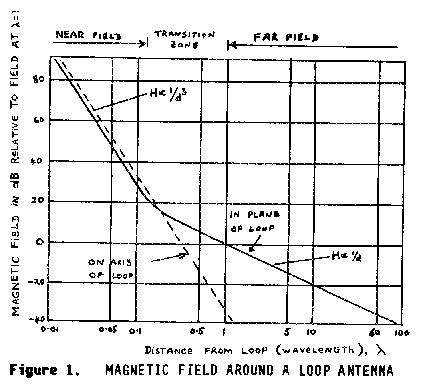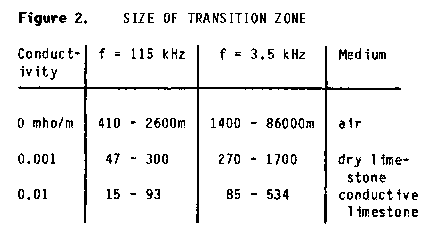MAGNETIC MOMENTS, Number 6:
THE TRANSITION ZONE
(originally printed in Speleonics 8, Summer, 1987)
By Ian Drummond
When any antenna transmits an electromagnetic (EM) field, it is surrounded by three zones; the far field zone, the near field zone and the transition zone between them.
The far field is the zone of conventional radio transmission, more than one wavelength from the antenna, where there is a radiated signal (a propagating EM wave). The EM wave consists of oscillating electric (E) and magnetic (H) fields which are at right angles to each other and the direction of travel. The two fields have a certain ratio of intensity (E/H = 120 p ohms in a vacuum) and this intensity decays proportionally to the inverse of the distance from the antenna. Therefore the power of the field decays proportionally to the inverse square of the distance (the well-known inverse square law). Around a loop antenna the radiated field is maximum in the plane of the loop and is essentially zero along the axis of the loop.
The near field is the zone close to the antenna, less than 1/2p wavelengths away. Normal cave radio operation takes place in the near field of a loop antenna. In this zone the intensities of the magnetic and electric fields are determined by the shape of the antenna and need not have a particular ratio. The magnetic field around a loop antenna decays with the inverse cube of the distance, and consequently the power of the field decays as the inverse sixth power of distance. Moreover the magnetic field is more intense along the axis of the loop than in the plane and so the greatest range of a cave radio is normally when the receiver is located on the axis of the transmitter loop.
The transition zone is the zone from 1/2p to one wavelength from the antenna. In this zone the magnetic field along the axis of a loop antenna continues to decay as the inverse cube of the distance, but the field in the plane of the loop decays less rapidly and so becomes more intense than the magnetic field on the axis (Fig. 1).

The consequences of this information are interesting. If a cave radio system can be built of sufficient range to operate in the transition zone (receiver sensitivity and selectivity; and transmitter power) then the greatest range will be with the receiver in the plane of the transmitting loop. Moreover, any further increments in performance will yield much greater benefits in range than for a radio operating in the near field.
Is it practical to build cave radios which might operate into the transition zone? The ASS cave radio operates at 115 kHz, which corresponds to a wavelength of 2.6 km in air. However when the units are used "thru-the-earth" the conductivity of the medium reduces the wavelength of the EM waves (Fig. 2).

Wavelength (m) = 2Ö (p /f m s)
in a conductive medium (s >> 2p f eo er)
| where: f = | frequency (Hz) |
| s = | conductivity (mho/m) |
| m = | 4p x10-7 H/m |
| eo = | 9 x10-12 F/m |
| er = | relative dielectric constant (10 for limestone) |
Clearly the ASS radio with a range exceeding 400m through dry limestone is operating in the transition zone. Indeed I believe these effects are responsible for the practical success of the several radios operating near 100 kHz, whose performance exceeds that predicted on the basis of near-field models.
Return to the Top of the Page
Copyright © 2000 Communications & Electronics Section of the NSS, Inc. - All Rights Reserved.